Winning Flounder Strategies
Ken Neill
published in the Chesapeake Angler
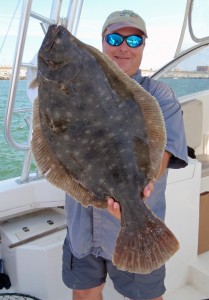 Each summer, hundreds of Virginia’s finest flounder fishermen gather together to compete against each other in the Flounder Bowl. Winning this tournament is not a “fluke”. These anglers are not drifting around out there, with their minnow and squid baits, hoping for a big flounder. They will be fishing particular areas, using specialized techniques designed to target the largest of the Old Dominion’s flatfish. We are going to explore some of these tournament-winning strategies.
Each summer, hundreds of Virginia’s finest flounder fishermen gather together to compete against each other in the Flounder Bowl. Winning this tournament is not a “fluke”. These anglers are not drifting around out there, with their minnow and squid baits, hoping for a big flounder. They will be fishing particular areas, using specialized techniques designed to target the largest of the Old Dominion’s flatfish. We are going to explore some of these tournament-winning strategies.
Structure is King
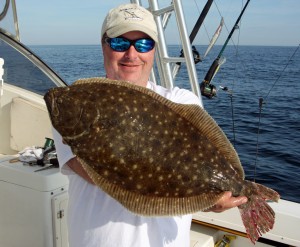 The overriding theme to all of the winning strategies is that the largest flounder are very structure oriented. These trophy flounder anglers will target specific pieces of structure and at times, very small areas. It is amazing how many large flounder will crowd into a small area when the conditions are right. These structures include the wrecks and artificial reefs inside and near the mouth of the Chesapeake Bay. Some of the most productive structures are the Cape Henry Wreck, Back River Reef, and the Cell, though any of the wrecks and reefs can produce large flounder. What they all have in common is that they concentrate forage, provide current breaks and provide good ambush points for a hungry flounder. You will find depressions, next to these structures, caused by current washout. Flounder will stack up in these areas and wait for food to be brought to them.
The overriding theme to all of the winning strategies is that the largest flounder are very structure oriented. These trophy flounder anglers will target specific pieces of structure and at times, very small areas. It is amazing how many large flounder will crowd into a small area when the conditions are right. These structures include the wrecks and artificial reefs inside and near the mouth of the Chesapeake Bay. Some of the most productive structures are the Cape Henry Wreck, Back River Reef, and the Cell, though any of the wrecks and reefs can produce large flounder. What they all have in common is that they concentrate forage, provide current breaks and provide good ambush points for a hungry flounder. You will find depressions, next to these structures, caused by current washout. Flounder will stack up in these areas and wait for food to be brought to them.
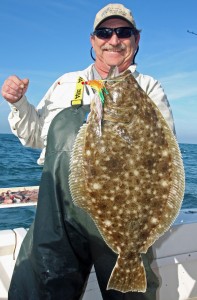 The largest piece of flounder structure in the bay is the Chesapeake Bay Bridge Tunnel. Large flounder can be found all along this structure but certain areas are known for producing the largest flounder. The four rock islands of the CBBT are all good flounder areas. Specifically, the washout areas at the ends of the islands, both the tunnel and bridge end. The curve, near the third island has a lot of bottom structure. A very good area can be found past the forth island as you are heading towards the Eastern Shore. The first “pull off” area of the old (seaside) span, where the bridge goes from three pilings to four has a lot of rock on the bottom. There is a span of about four piling sets that will hold large flounder in all of that structure. Further down the span, the pilings near the high-rise section have a lot of rubble around them that big flounder like to hang out next to.
The largest piece of flounder structure in the bay is the Chesapeake Bay Bridge Tunnel. Large flounder can be found all along this structure but certain areas are known for producing the largest flounder. The four rock islands of the CBBT are all good flounder areas. Specifically, the washout areas at the ends of the islands, both the tunnel and bridge end. The curve, near the third island has a lot of bottom structure. A very good area can be found past the forth island as you are heading towards the Eastern Shore. The first “pull off” area of the old (seaside) span, where the bridge goes from three pilings to four has a lot of rock on the bottom. There is a span of about four piling sets that will hold large flounder in all of that structure. Further down the span, the pilings near the high-rise section have a lot of rubble around them that big flounder like to hang out next to.
 So far, we have talked about hard structures. There is another type of structure that anglers will fish for trophy flounder: channel edges. The Baltimore Channel is the main channel coming into the Chesapeake Bay. Big flounder will use this as a super highway and large flounder will be caught all along it. The channel edge is good but we need something more to concentrate large fish for us. Areas of live or rough bottom near the channel is prime. You will find bottom like this in the buoy 42 area of the Baltimore Channel. Near buoy 36A, of the North Channel, is another area to find live bottom. Both the buoy 42 and 36A areas are well known for producing large flounder.
So far, we have talked about hard structures. There is another type of structure that anglers will fish for trophy flounder: channel edges. The Baltimore Channel is the main channel coming into the Chesapeake Bay. Big flounder will use this as a super highway and large flounder will be caught all along it. The channel edge is good but we need something more to concentrate large fish for us. Areas of live or rough bottom near the channel is prime. You will find bottom like this in the buoy 42 area of the Baltimore Channel. Near buoy 36A, of the North Channel, is another area to find live bottom. Both the buoy 42 and 36A areas are well known for producing large flounder.
If you can use a minnow to catch a flounder, will a larger minnow catch a larger flounder? The answer is yes. You will find that many of the tournament anglers have left the minnows behind in favor of larger live baits for flounder. Live spot has become the prime bait for doormat flounder. Other live fish like small croaker, mullet, and perch all make excellent baits for large flounder. If you do not have live fish, strips of cut fish work just fine. Again, the theme is large baits for large flounder. The length of your strips is 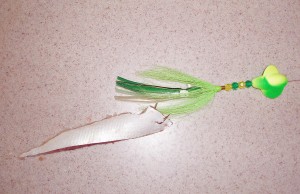 often based on the size of the fish you get them from. Bluefish, flounder, cobia belly, and false albacore are all used to make strip baits from. Any fish that you have access to can be used to make strip baits.
often based on the size of the fish you get them from. Bluefish, flounder, cobia belly, and false albacore are all used to make strip baits from. Any fish that you have access to can be used to make strip baits.
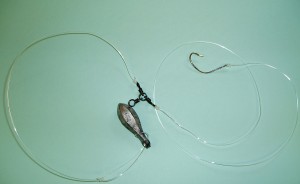 The basic terminal tackle for flounder is a 3-way swivel with a short leader to a sinker and another leader to your hook. The Kahle style hook is used by most flounder fishermen. It is typically a plain hook when using live fish as bait. When strip baits are used, the hook will be dressed up with colorful bucktails, spinners, or other attractors.
The basic terminal tackle for flounder is a 3-way swivel with a short leader to a sinker and another leader to your hook. The Kahle style hook is used by most flounder fishermen. It is typically a plain hook when using live fish as bait. When strip baits are used, the hook will be dressed up with colorful bucktails, spinners, or other attractors.
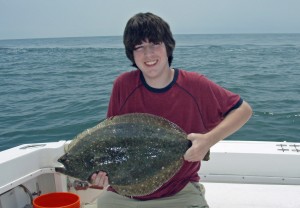 Another productive way to target large flounder is to get rid of this 3-way swivel rig and just use a jig to fish the bottom structure. The jig hook can be baited with a cut fish strip or use an artificial bait like the Gulp baits.
Another productive way to target large flounder is to get rid of this 3-way swivel rig and just use a jig to fish the bottom structure. The jig hook can be baited with a cut fish strip or use an artificial bait like the Gulp baits.
The actual fishing technique will vary with the structure and the bait being used. While fishing live bait around the hard structures, the captain can use the boat engine to hold the anglers over the productive bottom. This is done a lot at the CBBT. Jigs can also be used to probe the bottom around the structure while the captain keeps the boat in the sweet spot. Some anglers will anchor on the structure when using live bait. Cast your bottom rig up current and let it be swept down the structure to a waiting flounder. This technique is typically used on the wrecks  and artificial reefs. When using live baits, the angler relies on the bait to provide the action to entice a big flounder to bite. With strip baits, there needs to be movement to give the bait action. You can use strip baits (and live baits) while drifting, but you will often find the serious flounder sharpies slow trolling their strip baits over productive bottom. You will see them with smaller motors for trolling or dragging, sometimes elaborate, drift sock setups to slow their trolling speed down. When they find a small area holding flounder, they will work it hard, not relying on current and wind to drift them over the same area again. This is a favorite technique around the buoy 42 area.
and artificial reefs. When using live baits, the angler relies on the bait to provide the action to entice a big flounder to bite. With strip baits, there needs to be movement to give the bait action. You can use strip baits (and live baits) while drifting, but you will often find the serious flounder sharpies slow trolling their strip baits over productive bottom. You will see them with smaller motors for trolling or dragging, sometimes elaborate, drift sock setups to slow their trolling speed down. When they find a small area holding flounder, they will work it hard, not relying on current and wind to drift them over the same area again. This is a favorite technique around the buoy 42 area.
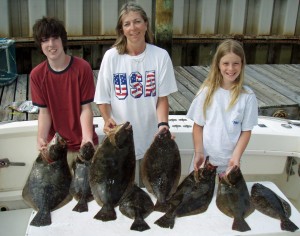 Almost all flounder anglers are using braided fishing line now. Exceptions to this are those trolling for flounder around hard structures. Here, wire-line offers protection from abrasion. Wire-line trolling can be used anywhere but it is at the CBBT where you will find this technique used the most. The rig is the regular flounder 3-way swivel setup with a much longer leader to your hook. Here, the “hook” is typically a bucktail jig dressed with a strip bait. These trophy
Almost all flounder anglers are using braided fishing line now. Exceptions to this are those trolling for flounder around hard structures. Here, wire-line offers protection from abrasion. Wire-line trolling can be used anywhere but it is at the CBBT where you will find this technique used the most. The rig is the regular flounder 3-way swivel setup with a much longer leader to your hook. Here, the “hook” is typically a bucktail jig dressed with a strip bait. These trophy 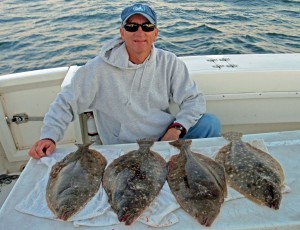 flounder hunters will slowly troll along the up-current side of the structure while keeping their sinker in contact with the bottom. The current sweeps the light bucktail jig towards the structure where the flounder are waiting. Wire-line trolling is not done as much now that fishing with live spot has become so popular. It is still a very productive technique for those who are good at it and I would not be at all surprised to see a wire-liner holding this year’s Flounder Bowl Trophy.
flounder hunters will slowly troll along the up-current side of the structure while keeping their sinker in contact with the bottom. The current sweeps the light bucktail jig towards the structure where the flounder are waiting. Wire-line trolling is not done as much now that fishing with live spot has become so popular. It is still a very productive technique for those who are good at it and I would not be at all surprised to see a wire-liner holding this year’s Flounder Bowl Trophy.
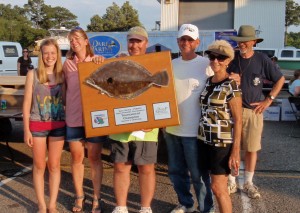 You can visit the Flounder Bowl on Facebook and visit www . pswsfa.com to find out more about the current and past Chesapeake Bay flounder champions.
You can visit the Flounder Bowl on Facebook and visit www . pswsfa.com to find out more about the current and past Chesapeake Bay flounder champions.


